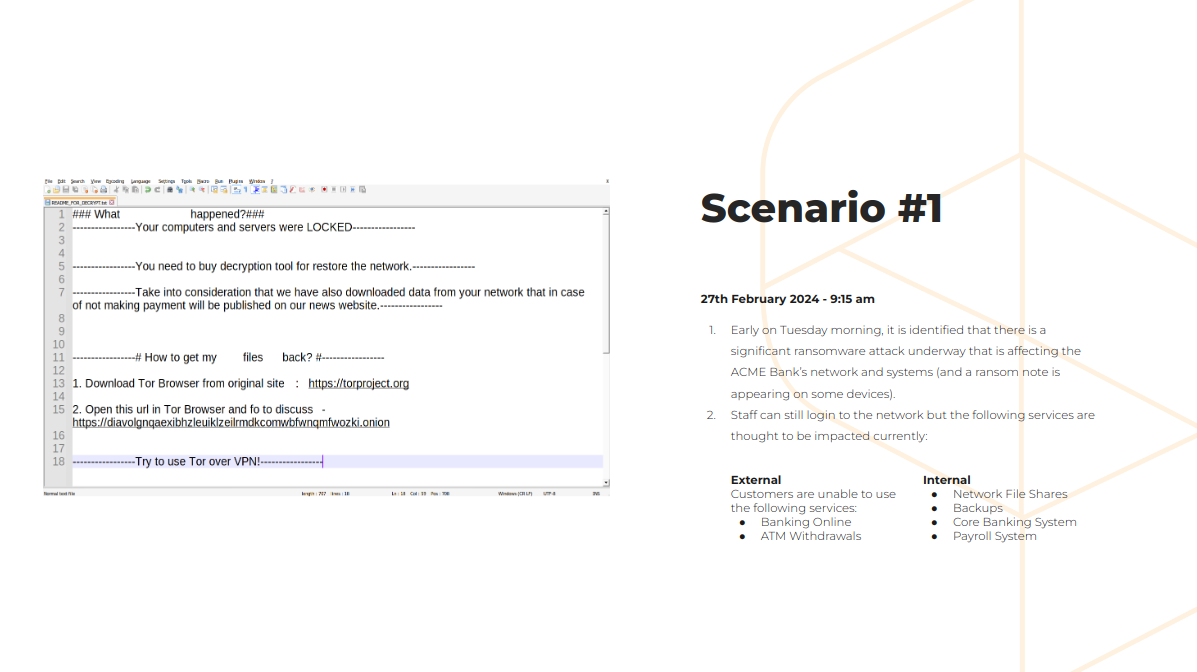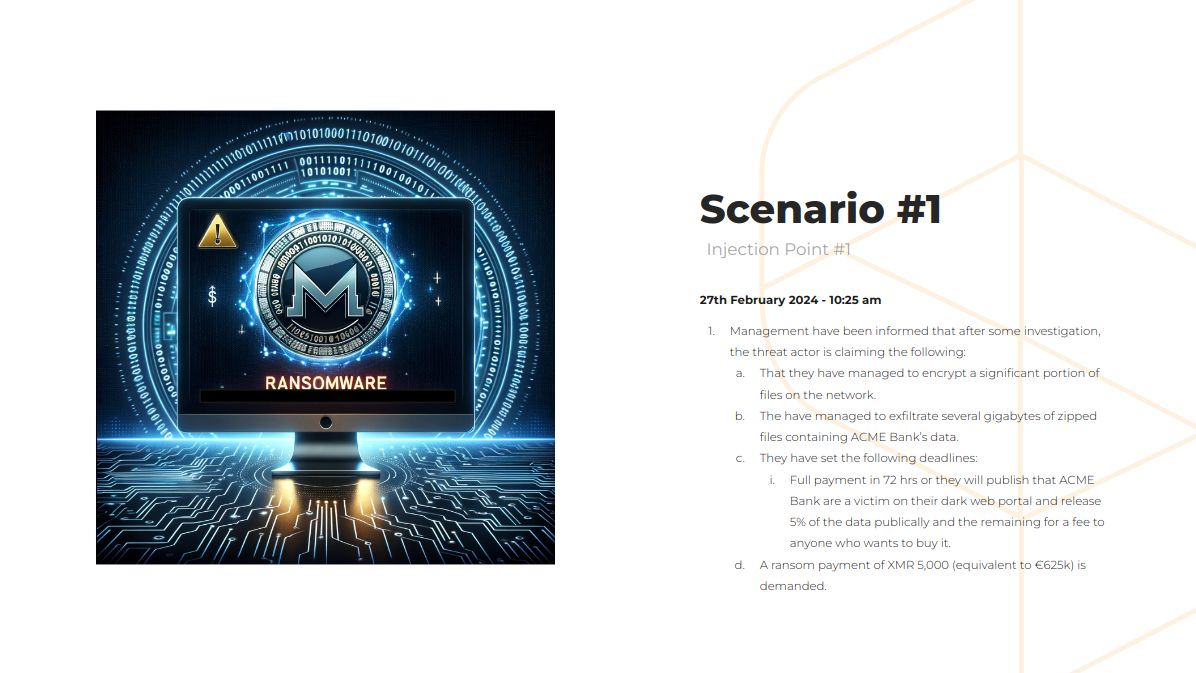A crisis management exercise is a structured and simulated activity designed to test and enhance an organisation’s ability to respond effectively to crises or emergencies. These activities should not be typical check-the-box exercises, but rather a technique to prepare everyone for the worst by developing a resilient and prepared team. These exercises can help businesses transform hypothetical events into concrete strategies, allowing them to deal with incidents or crises confidently and successfully.
Effective preparation is essential for making these activities meaningful, pushing teams, and boosting communication both internally and externally. To effectively tackle today’s challenges, businesses may integrate resilience into their core operations by following a disciplined strategy. This article will explore our approach and how we have successfully enhanced the significance and efficiency of these exercises for our customers.
In this blog:
- Define Objectives and Scope
- Develop Realistic Scenarios
- Formulate Teams and Assign Roles
- Conducting Briefings and Introducing Scenarios
- Start the Exercise
- Testing Communication and Decision-Making
- Evaluation and Debrief
- Detailed Analysis
- Developing Recommendations
- Documenting Outcomes and Recommendations
- Crafting a Comprehensive Report
- Issuing the Report
- Following Up and Implementing Improvements
- Implementation of Recommendations
- Learning and Adaptation
- The Value of Continuous Improvement
Planning and Preparation
Define Objectives and Scope
An effective crisis management exercise is built on a solid foundation of preparation, which begins with a clear explanation of its objectives and scope. This initial stage ensures that all aspects of the exercise are consistent with the businesses strategic goals, risk profile, and operational reality.
Setting Objectives
Establishing what the exercise aims to achieve is critical in ensuring the success of the exercise. Objectives can include analysing the operational impact of a simulated crisis, testing the resilience of communication channels, and gauging the effectiveness of decision-making under pressure. There are many ways in which you can set objectives, but one example may be using the SMART technique, or Specific, Measurable, Achievable, Relevant, and Time-bound. This will give the exercise’s planning and implementation a defined structure.
Scope Determination
Deciding on the scope involves selecting the types of crises to simulate. An extensive risk assessment that identifies the hazards most pertinent to the business should guide this selection. A few things to think about include the possibility of various crisis situations, how they might affect operations, and the level of preparedness exhibited by the business. The scope could be broad to include a variety of crisis scenarios, or narrow to concentrate on a specific kind of disaster, such a cyberattack.
Develop Realistic Scenarios
The creation of realistic scenarios is vital in challenging the participants and testing the businesses crisis response mechanisms effectively. Realism adds value by ensuring the exercise mirrors potential real-world crises as closely as possible, thereby providing genuine learning opportunities and keeping participants engaged and interested.
Basing Scenarios on Risk Assessment
Scenarios should stem from the businesses risk assessment, ensuring they are both plausible and relevant. This involves understanding the current threat landscape, the businesses vulnerabilities, and potential external impacts.

|
| Image 1: Risk Assessing Likely Scenarios |
Incorporating Complexity
To truly test the businesses resilience, scenarios should be complex and dynamic, requiring participants to navigate evolving challenges as the exercise unfolds. This could involve introducing unexpected developments or “Injection Points” that simulate real-world unpredictability, forcing teams to adapt their strategies on the fly.
Formulate Teams and Assign Roles
The effectiveness of a crisis management exercise also depends on the active participation of a cross-section of the business. Formulating teams and assigning roles is a strategic exercise that ensures comprehensive engagement across departments and levels.
Identifying Key Participants
A wide range of people should be involved, including representatives from the executive team, operational departments, IT, communications, and any other departments that would be involved in a real crisis. This diversity guarantees that a broad spectrum of viewpoints and levels of competence are included in the exercise.
Assigning Roles and Responsibilities
For the length of the activity, each participant should have a distinct role and set of tasks. These roles might be modified to test alternative dynamics and response techniques, or they could reflect their actual responsibilities. Clear role definition helps in minimising confusion and ensures that the exercise runs smoothly.
Execution
Conducting Briefings and Introducing Scenarios
A comprehensive briefing is necessary before the exercise starts in order to establish goals, define expectations, and present the situation in a way that will pique participants’ interest without outlining the exact difficulties they will encounter.
Pre-Exercise Briefing
The purpose of this session is to make sure that each participant is aware of the goals, duties, and scope of the exercise. It’s also an opportunity to emphasise the exercise’s importance for the businesses resilience and to encourage active, thoughtful participation.
Scenario Introduction
Presenting the crisis scenario effectively sets the stage for the exercise. This involves finding the right balance between giving enough information to make the scenario plausible and leaving enough room for uncertainty to necessitate quick decision-making and problem-solving. The goal of the introduction is to draw the participants in and fully immerse them in the crisis simulation.

|
| Image 2: Introducing the Scenario |
Start the Exercise
With the groundwork laid, the exercise begins, simulating the unfolding of the crisis in real-time. This phase is designed to test the businesses preparedness, response strategies, and adaptability to changing conditions.
Real-Time Simulation
Real-time execution of the exercise simulates the tempo and intensity of a real crisis, adding pressure and authenticity. As the situation develops, participants must navigate it by making choices and changing their tactics in response to new facts.
Injection Points
To add complexity and challenge to the exercise, planned “injection Points” or unexpected developments can be introduced. These should be designed to test specific aspects of the crisis response plan, such as communication effectiveness, decision-making under pressure, and the coordination of different departments or teams.

|
| Image 3: Adding Injection Points to the Scenario |
Testing Communication and Decision-Making
A critical component of the exercise is assessing the businesses internal and external communication strategies, as well as the decision-making processes under the stress of a crisis.
Internal Communication
The exercise should simulate the communication challenges typically faced during a crisis, testing the effectiveness of internal communication channels and protocols. This can involve coordination between departments, information sharing, and command structure effectiveness.
External Communication
Simulating interactions with external stakeholders, including media, customers, regulatory bodies, and possibly the general public, is crucial. This tests the businesses ability to manage its message, maintain public confidence, and fulfil any legal or regulatory reporting obligations.
Evaluation and Debrief
Immediate Debrief
A planned debriefing session offers a forum for participants to discuss their experiences and insights straight after the exercise. This immediate reflection is invaluable for capturing the raw observations that might be polished over time.
Initial Feedback
Obtain initial feedback from each participant to understand their perspective on the organisational challenges encountered and their individual performances during the exercise. Encourage candid and constructive feedback that focuses on what worked, what didn’t, and why is crucial to achieving the desired outcomes and lessons learned.
Detailed Analysis
Following the initial feedback, there should be a more in-depth examination of the exercise. This entails reviewing the goals, the steps you took during the exercise, and the results to evaluate your overall performance and pinpoint areas for improvement.
Performance Evaluation
Assess the degree to which the exercise’s goals were achieved. Analysing the efficiency of decision-making, communication, and the practical implementation of the crisis response plan all form part of this. Performance can be measured using particular performance indicators, such as response times, decision accuracy, and clarity of communication.
Identifying Strengths and Weaknesses
Highlight the areas in which the business excelled, highlighting strengths and best practices that worked well. Finding the gaps and flaws in the crisis response plan that need to be addressed and improved upon is just as crucial.
Actionable Insights
The goal of the analysis is to provide specific, actionable insights that can lead to real improvements. This means going beyond identifying what went wrong, but understanding why, and how it can be corrected.
Developing Recommendations
Provide a collection of concise, actionable recommendations for enhancing the businesses crisis management capabilities based on the thorough investigation. The potential impact and practicality of implementing these suggestions should determine their order of importance.
Short-Term Improvements
Identify quick wins that can be easily implemented to address immediate gaps in the crisis response plan.
Long-Term Strategic Changes
Identify longer-term recommendations that may involve more significant changes to procedures, training, or even organisational culture.
Documenting Outcomes and Recommendations
The reporting phase is where the insights and lessons learned during the crisis management exercise are formalised and shared. A comprehensive report serves multiple purposes:
- it acts as an official record, helps in communicating findings to key stakeholders, and;
- it provides a roadmap for future actionable items
Crafting a Comprehensive Report
Creating a detailed report involves collating all the data, feedback, and analyses gathered during the exercise and presenting them in an organised and accessible format.
Executive Summary
The executive summary should give a high-level rundown of the exercise’s goals, important conclusions, key insights and actionable recommendations. For top management and other stakeholders who might not read the entire report, this part is essential to ensure decision makers to grasp the most important information and make informed decisions.
Detailed Findings
A comprehensive description of the exercise, from the stages of planning and execution to the debrief and evaluation, should be included in the report’s body. Thorough explanations of the scenarios that were used, the participant’s actions and the difficulties that were faced. To demonstrate the dynamics of the exercise, this part ought to be filled with several concrete instances and observations.
Analysis and Recommendations
Present a detailed analysis of the exercise’s outcomes, highlighting both strengths and areas for improvement. Recommendations that outline concrete measures to improve the businesses crisis management plan should be made in a manner that is directly related to the findings. These recommendations can be categorised by priority or by the relevant department or function for easier implementation.
Issuing the Report
When the report is finished, it should be issued to all relevant parties, such as top management, participants in the exercise and any departments or teams assigned to carry out the suggestions.
Stakeholder Briefings
To discuss the report’s conclusions and suggestions with key stakeholders, think about organising briefings in addition to distributing the document. This can help readers comprehend the report’s contents more thoroughly and encourage teamwork in resolving the suggested improvements.
Feedback
Invite interested parties to comment on the report and its suggestions. This input can be valuable for improving the suggested activities and making sure they are realistic and in line with the strategic objectives of the business.
Following Up and Implementing Improvements
The follow-up phase is pivotal in ensuring that the insights and recommendations derived from the crisis management exercise lead to tangible improvements. This phase involves developing a systematic approach to implementing changes and reinforcing the businesses commitment to continuous improvement in crisis readiness.
Implementation of Recommendations
Turning the recommendations into action is the most critical step in the follow-up phase. This requires a coordinated effort across the business, with clear ownership and timelines for each recommendation.
Action Plan Development
Create a detailed action plan that outlines the steps needed to implement each recommendation, assigning clear responsibilities and deadlines. This plan should consider both short-term fixes and long-term strategic changes, ensuring a balanced approach to improvement.
Prioritisation
Given the likely breadth of recommendations, prioritise actions based on their potential impact on enhancing crisis readiness and the resources required. This helps to ensure that the most critical improvements are addressed promptly.
Continuous Improvement
Improving a businesses crisis management skills is a continuous effort. Constant improvement ensures the business is flexible and can respond quickly to emerging risks and challenges.
Regular Review and Update of Crisis Plans
Plans for crisis management should be dynamic documents that are constantly evaluated and revised in light of fresh information, new dangers, and modifications to the businesses operations or external environment. This guarantees the plans’ continued applicability and efficiency.
Scheduled Crisis Management Exercises
Regularly scheduled exercises are essential for testing and refining the crisis management plan. Each exercise should build on the lessons learned from previous ones, gradually enhancing the businesses crisis readiness.
Learning and Adaptation
The ability of firms to adapt and learn is what really makes crisis management exercises and the follow-up phase valuable. This necessitates a culture that values making amends for transgressions, being honest about flaws, and always looking for ways to get better.
Feedback Mechanisms
Establish mechanisms for ongoing feedback on the crisis management process, encouraging input from all levels of the business. This can include surveys, debrief sessions, or regular meetings dedicated to crisis management and readiness.
Knowledge Sharing
Foster an environment where the insights gained from crisis management exercises are shared widely within the business. This can involve creating knowledge repositories, holding learning sessions, or incorporating lessons into training programs.
Conclusion
Crafting, implementing, and reviewing crisis management exercises are essential components that are fundamental to a businesses ability to recover from an incident and leverage the experience to enhance its resilience. This articles aim was to give you a structure to turn theoretical plans and documents into a more practical exercise.
By establishing objectives, conducting realistic crisis scenarios, assessing them, documenting lessons learned, and adjusting as needed, there is a focus on progression and continuous improvement.
The Value of Continuous Improvement
Probably the most important lesson learned from crisis management exercises is that being prepared is an ongoing goal rather than a one-time accomplishment. Every exercise reveals fresh perspectives and opportunities for development, highlighting the necessity for companies to be watchful, flexible, and lifelong learners. Through the cultivation of an atmosphere that values feedback and views failures as chances for progress, organisations can develop resilience not only as a reaction strategy but also as an essential characteristic of their operations.
Businesses can make sure they are always growing and prepared to take on new challenges by committing to regular exercise, careful evaluation, and persistent follow-up.
To sum up, when a business carries out effective crisis management exercises, it is an investment in the security and safety of its resources, personnel, and other stakeholders. Perhaps most significant, though, is that it’s an investment in creating a robust business that can overcome setbacks, adjust to change, and emerge stronger.
If you would like further information on how Secora Consulting can assist you in facilitating you in conducting crisis management exercises , please get in touch by filling out the form below 👇.


